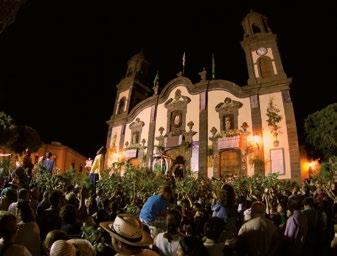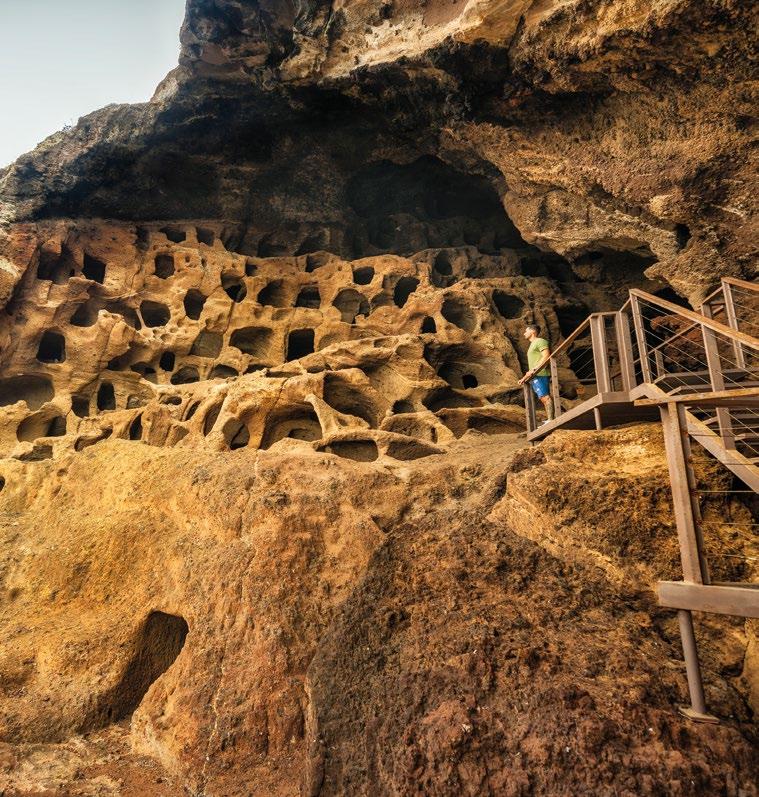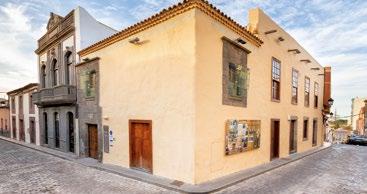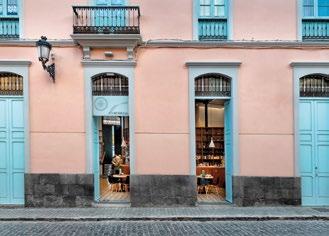Festivals
THE VIRGIN FESTIVAL
The Patron Saint Festival in honor of the Virgin of Guía takes place during the first fortnight of August. The bid day is the 15th, featuring a morning procession and the Flower Battle in the afternoon. Many cultural events are held during this time, with the “papagüevos” parades (giant papier-mâché figures and true stars of the festivities), the float parade, and the aforementioned Flower Battle standing out.
LAS MARÍAS FESTIVAL
This festival commemorates the tradition of the Vergara vow made in 1811, when local farmers promised to descend every year from the “medianías” (midlands of the island) to Guía in gratitude to the Virgin for delivering them from a major locust plague. The festival is held every year on the third weekend of September and consists of two main events: the Bajada de la Rama (Branch Procession) from the “medianías” to Guía on the Saturday, and the Procession and Pilgrimage on the Sunday at noon. During these events, the sound of conch shells and drums is prominent, echoing the instruments used to scare off the plague. The pilgrimage is said to be one of the purest, most beautiful, and traditional in all the Canary Islands.
THE CHEESE FESTIVAL
Held in two editions: the last weekend of April in the historic center and the first weekend of May in Montaña Alta. Cheesemakers and other artisans offer their best products, with tastings of typical foods and demonstrations of traditional activities related to livestock and herding.
Santa María de Guía Tourist Information Office
Calle Marqués del Muni, 34
35450 Santa María de Guía
Tel: (+34) 928 896 555 ext 403 turismo@santamariadeguia.es
www.descubreguia.com
SANTA MARÍA DE GUÍA
Flor” Cheese Croquettes Typical Recipe
“Media
PREPARATION
Finely chop the onion and garlic, and leave to simmer in a pan with the bacon and the butter, avoiding it to change its colour. Make a roux, adding the flour and butter, stir for a while and add the milk, little by little. Leave to simmer, season with salt, pepper and nutmeg. Let it thicken while stirring constantly, and when it’s nearly done add the “media flor” cheese and the dates, chopped. Leave aside until cold. Form the croquettes and dip in flour, egg and finally bread crumbs. Fry in abundant hot oil. Serve with tomato marmalade.
Flower Cheese Guía Sweets
Lengüillas cakes
Llegada Rama Las Marías.
At the northwest of the island of Gran Canaria between the municipalities of Moya and Gáldar and 22 kilometres from the capital. It covers a land surface area of 42.59 square kilometres which extend from the sea up to the summit.
Did
• The name of Santa María de Guía is in honour of the Virgin of Guía, the patron saint of the municipality, and the town was founded immediately following the conquest of the island.
• Many illustrious figures have graced the region throughout its history; these range from craftsmen and women, politicians, musicians, poets and sculptors, who especially between the 18th and 19th centuries, placed the municipality at the forefront of the Canary Islands. Leading examples include sculptor Luján Pérez, clergyman and politician Canónigo Gordillo and the great musicologist and researcher Néstor Álamo, among others.
• Guía Flower cheese has been made at this northwest region of the island since the 16th century. The name “Guía” features on it because it was at its market, from the 19th century onwards, where it became famous. What makes it such a special product, alongside the vegetable rennet used in its production, is the rich, green farmland used by the Canary breed of sheep for grazing and the wholly artisan nature of its manufacturing process.
Cenobio de Valerón is the gateway to the municipality of Santa María de Guía. This archaeological site, made up of nearly 300 caves carved into volcanic tuff and located at the Cuesta de Silva (GC-291), is the most spectacular and largest preHispanic granary in Gran Canaria. During the visit, you’ll learn about the importance of agriculture in the aboriginal production model as a fundamental pillar of their livelihood and sociopolitical organization. The visit also covers the area’s flora and fauna, volcanic geology, and, of course, all the archaeological aspects of the site.
Nearby is Camino Real de la Cuesta de Silva, which connected the capital with the North and was already used in aboriginal times. After Cenobio de Valerón, a visit to the Historic Center (declared a Historic-Artistic Monument) is a must. A stroll along its streets reveals the beauty of its buildings and transports visitors to the splendor of days gone by. Notable constructions include the Parish Church (built between the 17th and 19th centuries) with its Baroque façade flanked by two Neoclassical towers and inside, important works of art –especially altarpieces and sculptures by the renowned local sculptor José Luján
Pérez, who also features prominently in the town’s spectacular Holy Week celebrations; Casa de los Quintana (a 16th-century manor house); the birthplace of Néstor Álamo (17th century); and the Chapel of San Roque (16th century, restored in the 19th century in an eclectic style).
Other points of interest in the historic center include the factory where Guía’s traditional sweets are still made, and shops where you can taste the famous Flor de Guía cheese. Along the way, you’ll also see numerous splendid examples of the city’s varied architecture, with the Gran Canarian façade and Neoclassical architecture being among the best examples in the
archipelago. One of these landmark buildings houses La Bodega tourist interpretation center, where, in addition to tourist information, you can taste and purchase cheese and other local products, as well as traditional crafts.
Also in the historic center is the Néstor Álamo Museum located in the house where this illustrious local musicologist and historian was born in 1906. The visit offers a chance to understand and enjoy the evolution of music in the Canary Islands, from the sounds created by the indigenous people two thousand years ago, through all the influences that shaped our traditional music, right up to today’s
How to get there
ALL BUSES LEAVE FROM SAN TELMO STATION SERVICE 105
Las Palmas de Gran Canaria - Gáldar SERVICE 103
Las Palmas de Gran Canaria - Gáldar SERVICE 100
Las Palmas de Gran Canaria - Gáldar
you know? popular music. This story unfolds across the different rooms of a 17th-century stately home, with the life and work of the multifaceted Néstor Álamo as the guiding thread. Álamo dedicated much of his life to research, the recovery of traditions, and, ultimately, to spreading the history and culture of Gran Canaria.
For those who prefer the sea and nature, the municipality offers that as well. Due to the rocky nature of its coastline, there are two main swimming areas: San Felipe beach, which is famous for its excellent surfing waves, and the natural pools of Roque Prieto, where you can enjoy the
sea in a family-friendly setting.
The “medianías” and highlands also offer landscapes and spaces for relaxation, such as the recreational areas of Santa Cristina and Monte Pavón, as well as spots for hiking. El Brezal Special Nature Reserve is one of the protected natural areas in the municipality. Here, a wellpreserved laurel forest – an example of Canarian “monteverde”-can be found, along with a wide network of circular trails for the whole family. Also in the “medianías”, in Montaña Alta, is Casa del Queso (Cheese House). At this interpretation center, you can taste and purchase the area’s excellent cheese and other local products, and learn about the entire artisanal production process and the ethnographic significance of the Canarian gourmet gem that is Flor de Guía cheese. Another place where cheese features alongside other local produce is the Guía Market.
Santa María de Guía
Cenobio de Valerón
RESERVA NATURAL DE EL BREZAL
Santa Cristina Tres Cruces
Bascamao La Dehesa
Monte Pavón Mirador de La Caldera de Los Pinos de Gáldar Montaña
Playa
Historic Town Centre.
Natural Pools of Roque Prieto.










